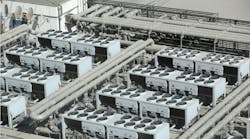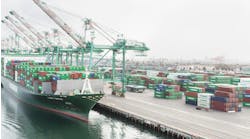Are You Missing Out on the Benefits of Climate Controlled Warehouses?
As the logistics industry adapts to new pressures, many warehouses have taken the chance to optimize their operations. Much of this shift centers around operational improvements, but environmental considerations deserve attention, too. A climate-controlled warehouse, as simple as it may seem, can make a significant difference.
Climate control systems are not necessarily new, but innovations like artificial intelligence (AI) and the Internet of Things (IoT) take their benefits higher than ever before. Failing to recognize that potential could lead logistic organizations to overlook crucial optimization opportunities.
What Makes a Climate-Controlled Warehouse?
Before diving into the advantages of a climate-controlled warehouse, it’s important to clarify what the term means. It’s easy to confuse these systems with temperature control solutions like air conditioning, but they’re not interchangeable.
Warehouse temperatures can exceed 80° even with cooling, so AC is a crucial part of climate control. However, the category goes further than heat management alone. It also covers solutions to address humidity, indoor air quality and sensors that monitor these factors.
Specific technologies under the umbrella include smart thermostats, dehumidifiers, HEPA filters and IoT sensors. Refrigeration solutions and building automation platforms appear in some advanced versions for warehouses with heightened needs.
Across all variables, the goal remains the same: using Industry 4.0 technology to maintain optimal indoor conditions. Investing in such infrastructure incurs higher upfront costs but yields several substantial benefits.
Product Preservation
Climate-controlled warehouses are most impactful in organizations managing sensitive goods. Food and beverage companies are a prime example, as they can use this technology to prevent the foodborne illnesses that affect 48 million people annually.
High temperatures make concerns like bacterial growth a much more prominent issue. Consequently, maintaining cooler indoor conditions minimizes the risks of product spoilage, ensuring more goods get to consumers in usable condition. These improvements, in turn, result in higher customer satisfaction and reduced losses from waste.
Humidity control has similar implications for warehouses storing electronics. Moisture can cause corrosion and circuitry faults, so active dehumidification saves money in the long run by preventing product damage. Wooden products and soft surfaces prone to contaminant growth benefit similarly from humidity management.
Equipment Maintenance
Advantages like this extend to the machinery within a warehouse, too. Poor indoor conditions make equipment maintenance issues more likely, so an advanced climate control system can reduce ongoing repair costs.
When the air around compressors gets too hot, it affects the performance of pneumatic tools by hindering the compressor’s operation. Excessive moisture can cause rust buildup in metal parts earlier than businesses may expect. By the same token, optimal temperature and humidity controls will ensure machines can work as efficiently and safely as possible for longer.
Protecting equipment by maintaining better operating conditions reduces long-term spending along two fronts. First, it minimizes the likelihood of unexpected breakdowns by removing some of the most pressing hazards. Secondly, it enables longer stretches between planned repairs, lowering replacement part costs and related downtime.
Workforce Benefits
Building a climate-controlled warehouse will also benefit employees. The most obvious advantage here is that avoiding extreme temperatures makes heat injuries and exhaustion less likely. However, the upsides do not end there.
Complete climate control solutions include air quality management. Such systems ensure warehouses remove contaminants from the air that may hinder workers’ safe breathing. This can be a crucial edge because respiratory hazards are not always easy to catch. Something as seemingly harmless as humidity can exacerbate respiratory diseases or aid their transmission.
As climate change worsens temperatures, environmental health factors will become an increasingly critical issue. Consequently, getting ahead of the trend and preventing the worst outcomes by ensuring better indoor conditions could prove a vital advantage.
Regulatory Compliance
In some industries, climate-controlled warehouses make it easier to comply with legal regulations. Food and beverage companies, for example, must protect products from biological contamination, which includes reasonable steps to prevent mold, bacterial growth and related spoilage. Temperature and humidity control are essential here.
Warehouse employees can meet regulations and protect customers without high-tech climate control, but it’s much harder. IoT-based systems are more reliable and efficient because they adapt to changing conditions and automate much of the management process.
Regulations like this may change in the future, especially around sensitive electronics. Adapting to such changes may be challenging in an entirely manual climate control system. Using a newer solution with automated features and a single point of access simplifies them, reducing the cost of compliance.
Best Practices for Implementing Warehouse Climate Control
As these benefits demonstrate, a climate-controlled facility gives logistics businesses a significant edge. Like most technologies, though, it requires careful implementation to achieve its full potential.
First, warehouse managers must determine which solutions best suit their specific situation. Temperature, humidity and air quality controls are critical in any context, but not every building needs them to the same level. Food and beverage organizations require refrigeration when others may not, and electronic goods necessitate stricter humidity levels. Businesses can make these decisions by reviewing applicable regulations and performing a risk assessment.
Likewise, warehouses should tailor their system according to what constitutes ideal conditions for their needs. Refrigerated food must sit below 40°F, while freezers should be below zero. Electronics, by contrast, are safest between 50 and 77° at under 50% relative humidity.
Implementing an advanced climate control solution across an entire warehouse can get expensive. Consequently, it may be best to take a gradual approach, starting with the most critical consideration and slowly integrating new technologies. A facility could begin with an IoT AC system before adding smart filtration and humidity sensors later on, for instance.
When deploying such a strategy, warehouses must ensure later investments are compatible with earlier ones. That includes using common IoT protocols and verifying that new endpoints can work with existing building automation platforms or warehouse management systems.
A Climate-Controlled Warehouse is a Must-Have Today
Heat, humidity and poor air quality are more destructive than they appear at first. They can lead to product waste, endanger employees, result in regulatory fines and impact equipment maintenance. In light of those risks, a climate-controlled warehouse will provide crucial advantages in all four areas.
Food businesses are not the only ones that benefit from such improvements. Capitalizing on them now can help organizations get ahead of rising demands and safety concerns.









